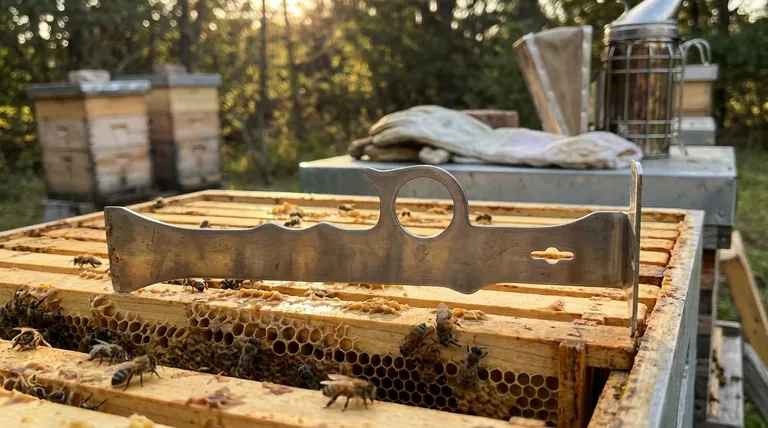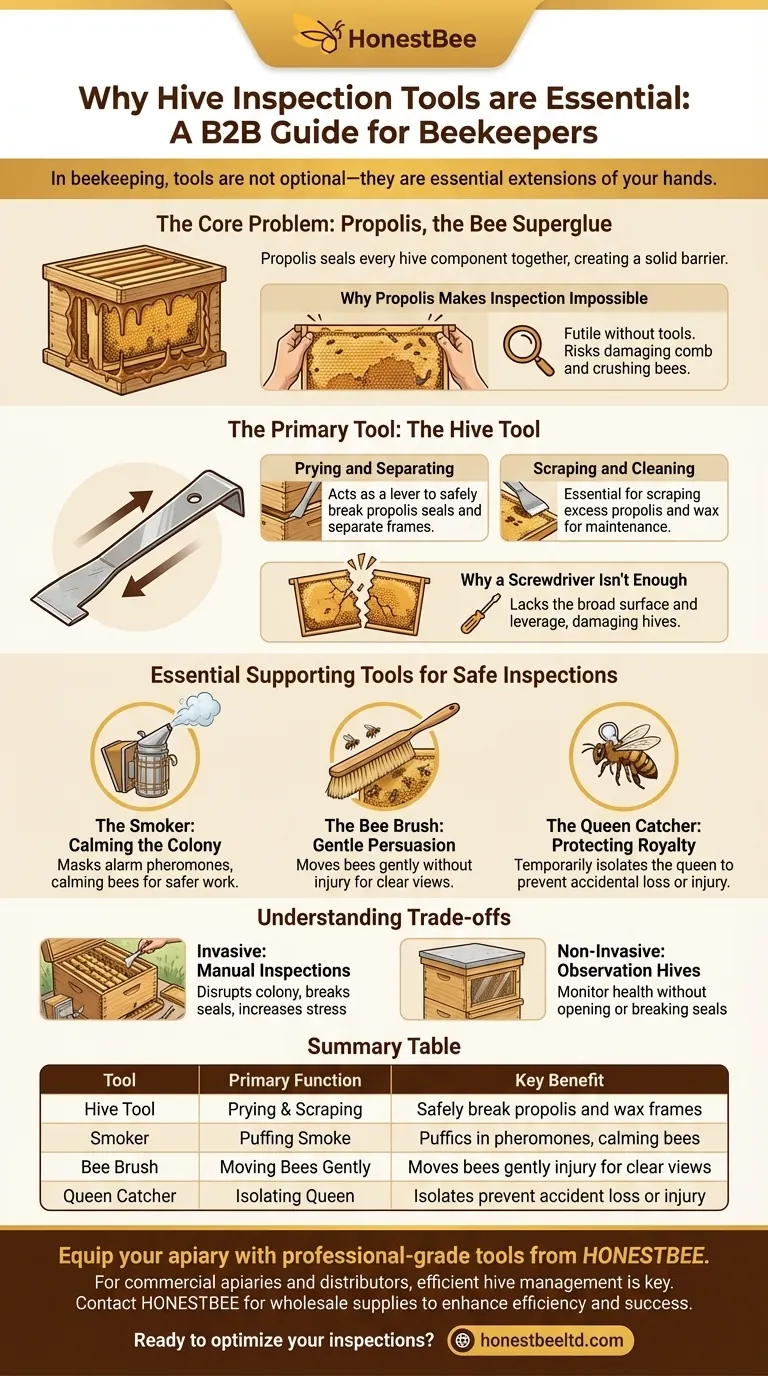In beekeeping, hive inspection tools are not optional—they are essential extensions of your hands. These tools are fundamentally important because bees use a powerful, resin-like substance called propolis to glue every component of their hive together. Without the right tools, a beekeeper cannot safely open the hive, separate the frames, or perform the critical health checks necessary to maintain a thriving colony.
The core challenge of beekeeping is that bees seal their hive into a single, solid unit. Hive inspection tools are specifically designed to overcome this natural barrier, allowing you to assess colony health and manage the hive without causing undue stress or harm to the bees.

The Core Problem: Propolis, the Bee Superglue
What is Propolis?
Propolis, often called "bee glue," is a resinous mixture that honey bees produce by mixing saliva and beeswax with exudates gathered from tree buds, sap flows, or other botanical sources.
Bees use this substance to seal small cracks and gaps in the hive, reinforcing its structural integrity and protecting it from the elements and intruders.
Why Propolis Makes Inspection Impossible
While beneficial for the bees, propolis creates a significant challenge for the beekeeper. The bees apply it to every contact point, effectively welding the frames, boxes, and lids together.
Attempting to open a hive or separate frames with your bare hands is futile and risks crushing bees and destroying delicate comb structures. This is the central problem that inspection tools are designed to solve.
The Primary Tool for Every Beekeeper: The Hive Tool
Prying and Separating
The most indispensable piece of equipment is the hive tool, a simple metal bar with a sharpened or angled end. Its primary function is to act as a lever.
A beekeeper uses the hive tool to gently pry apart hive bodies and break the propolis seal between frames, allowing for their safe removal and inspection.
Scraping and Cleaning
The flat, sharp edge of a hive tool is also used for scraping away excess propolis, beeswax, and burr comb from frames and hive boxes.
This routine cleaning is critical for hive maintenance, ensuring that frames fit properly and that you can conduct future inspections efficiently.
Why a Screwdriver Isn't Enough
While a screwdriver might seem like a substitute, it lacks the broad, flat surface and leverage of a proper hive tool.
Using inadequate tools can easily damage wooden frames and hive bodies, leading to costly repairs and creating gaps that bees will have to reseal, wasting valuable energy.
Essential Supporting Tools for Safe Inspections
The Smoker: Calming the Colony
A bee smoker is used to puff cool smoke into the hive before and during an inspection. The smoke masks the bees' natural alarm pheromones.
This interruption in their communication makes the colony less defensive and allows the beekeeper to work more calmly and safely.
The Bee Brush: Gentle Persuasion
A bee brush has long, soft bristles designed to gently move bees off a frame without injuring them.
This is essential when you need a clear view of the comb to check for eggs, larvae, or signs of disease, or when you are harvesting a frame of honey.
The Queen Catcher: Protecting Royalty
A queen catcher is a small clip or cage used to temporarily and safely isolate the queen during an inspection.
Securing the queen prevents the risk of accidentally crushing or losing her, which would be catastrophic for the colony's health and survival.
Understanding the Trade-offs: Invasive vs. Non-Invasive Methods
The Inherent Disruption of Manual Inspections
It's important to recognize that any manual inspection, no matter how carefully performed, is a disruptive event for the colony. It breaks their seals, changes the hive temperature, and causes stress.
The goal is always to be as efficient and gentle as possible, using the right tools to minimize the duration and impact of your presence.
The Role of Observation Hives
For beekeepers who wish to monitor their colony with less disruption, an observation hive can be a valuable tool.
These hives feature a glass or transparent side, allowing you to check on the bees' activity, population size, and general health without having to open the hive and break the propolis seals.
Making the Right Choice for Your Beekeeping Goals
- If you are a new beekeeper starting your first hive: Your non-negotiable first purchases are a sturdy hive tool and a reliable smoker.
- If you are focused on minimizing colony stress: Master your tools to make inspections quick and efficient, and consider supplementing them with non-invasive checks using an observation window.
- If your goal is to manage multiple colonies effectively: Proficiency with the full set of tools—hive tool, smoker, and bee brush—is essential for performing safe and thorough inspections at scale.
Ultimately, these tools empower you to work with your bees, transforming a sealed, inaccessible box into a manageable and thriving colony.
Summary Table:
| Tool | Primary Function | Key Benefit |
|---|---|---|
| Hive Tool | Prying apart boxes & frames, scraping propolis | Safely breaks bee glue seals without damaging hive |
| Smoker | Puffing cool smoke into the hive | Calms bees by masking alarm pheromones for safer work |
| Bee Brush | Gently moving bees off frames | Provides clear view of comb for health checks |
| Queen Catcher | Temporarily isolating the queen | Prevents accidental loss or injury to the colony's queen |
Equip your apiary with professional-grade tools from HONESTBEE.
For commercial apiaries and beekeeping equipment distributors, efficient hive management is the foundation of productivity and colony health. Our wholesale-focused operations supply the durable, reliable hive inspection tools you need to perform safe, swift inspections at scale. From essential hive tools to high-capacity smokers, our equipment is built to withstand the demands of professional beekeeping.
Ready to optimize your hive inspections and protect your investment? Contact HONESTBEE today to discuss your wholesale supply needs and discover how our tools can enhance your operation's efficiency and success.
Visual Guide

Related Products
- HONESTBEE Advanced Ergonomic Stainless Steel Hive Tool for Beekeeping
- Professional Galvanized Hive Strap with Secure Locking Buckle for Beekeeping
- Professional Frame Preparation: The HONESTBEE Electric Wire Embedder
- Electric Flatting and Embossing Machine with Tray for Beekeeping
- Multi-Functional Rotary Hive Entrance Disc for Beekeeping
People Also Ask
- How is a hive tool used for scraping and cleaning? Master Hive Maintenance for a Healthy Colony
- How should beekeepers handle bees when using a hive tool? Master Calm, Deliberate Techniques
- What are the features of a regular hive tool? The Essential Multi-Tool for Every Beekeeper
- What is a hive tool and what are its uses? Master Your Hive Inspections with the Essential Beekeeper's Tool
- What tools are used for cleaning frames? A Beekeeper's Simple 4-Tool Guide



















